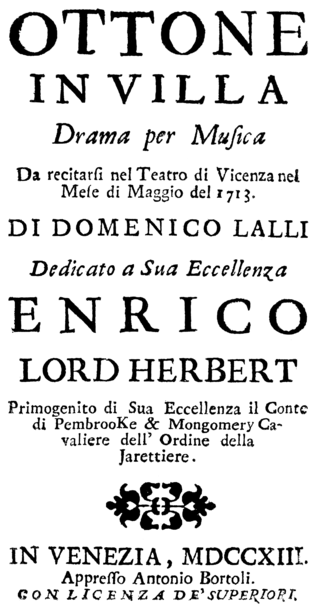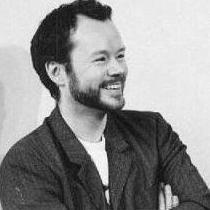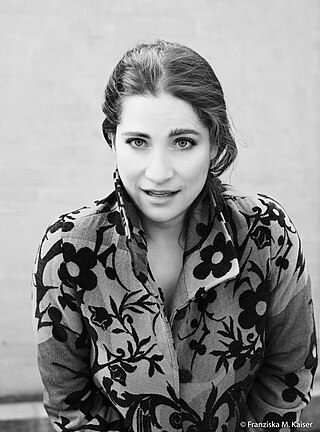Performance history
Jackie O received its first performance in the Cullen Theater, Houston, Texas, on March 14, 1997 with a second performance on March 16, 1997, both conducted by Christopher Larkin. The opera's Canadian premiere took place on August 7, 1997 at the Banff Centre in Alberta, conducted by Bruno Ferrandis. Co-produced by Houston Grand Opera's Houston Opera Studio and the Banff Centre, the premiere production was directed by Nicholas Muni, with sets and costumes by Peter Werner, lighting design by Harry Frehner, and choreography by Bruce Brown, who also created the role of Paparazzo. [1]
The work has subsequently received several other US performances including those by the Duquesne University Opera Workshop in Pittsburgh (1999), Long Leaf Opera in Chapel Hill, North Carolina (2003), and the University of Michigan School of Music, Theatre and Dance in Ann Arbor (2006). Jackie O had its French premiere on February 2, 2002 at the Opéra de Metz, [2] and its Italian premiere on April 3, 2008 in the Teatro Rossini, Lugo, in a co-production with the Teatro Comunale di Bologna. [3]
Synopsis
Wayne Koestenbaum has described the loose narrative of his libretto as a "collage" in the style of Gertrude Stein's libretto for Four Saints in Three Acts , an opera by 20th-century American composer, Virgil Thomson. Koestenbaum has written both poetry and non-fiction works on opera and on iconic opera singers like Maria Callas. [4] It is not surprising that in addition to the character of Maria Callas, there are several conscious allusions to the art-form in the Jackie O libretto. These include: Violetta's death aria from La traviata , reflected in Addio Del Passato; the funeral pyre from the final scene of Norma , reflected in The Flame Duet; and both Countess Almaviva's forgiveness aria in The Marriage of Figaro and the off-stage voice of the imprisoned Manrico in Il trovatore , reflected in Jack's Song. [5] [6]
Act I begins with a "happening" in artist Andy Warhol's studio in New York City, attended by various celebrities including Elizabeth Taylor, Grace Kelly, Aristotle Onassis, and his lover, Maria Callas. All eagerly anticipate Jackie and sing Jackie's Coming!. Jackie arrives and is fascinated by Onassis. Callas realizes that Onassis is going to leave her for Jackie and sings Addio Del Passato (Goodbye to the past). Onassis and Jackie escape from the party to see a new art movie, I Am Curious (Yellow) .
Act II is set on Onassis' yacht, Christina, and on his private island, Skorpios. Jackie and Onassis have now been married for a year. On the yacht, Jackie becomes increasingly melancholy and given to trance-like states. Maria Callas seeks a reunion with Onassis and the two decide to meet (I Will See You At The Lido). In one of her trances, Jackie wanders off to the island, where she and Maria Callas meet and reconcile with each other as they sing The Flame Duet. Jackie and Callas then smash a paparazzo's camera, which gives Jackie the power to communicate with her dead husband, who is heard as a disembodied voice. She forgives him for his past infidelities in their duet, Jack's Song. The opera ends with Jackie deciding to return to America, wistfully singing The New Frontier Is Here.

La traviata is an opera in three acts by Giuseppe Verdi set to an Italian libretto by Francesco Maria Piave. It is based on La Dame aux camélias (1852), a play by Alexandre Dumas fils, which he adapted from his own 1848 novel. The opera was originally titled Violetta, after the main character. It was first performed on 6 March 1853 at La Fenice opera house in Venice.

The Barber of Seville, or The Useless Precaution is an opera buffa in two acts composed by Gioachino Rossini with an Italian libretto by Cesare Sterbini. The libretto was based on Pierre Beaumarchais's French comedy The Barber of Seville (1775). The première of Rossini's opera took place on 20 February 1816 at the Teatro Argentina, Rome, with designs by Angelo Toselli.

La bohème is an opera in four acts, composed by Giacomo Puccini between 1893 and 1895 to an Italian libretto by Luigi Illica and Giuseppe Giacosa, based on Scènes de la vie de bohème (1851) by Henri Murger. The story is set in Paris around 1830 and shows the Bohemian lifestyle of a poor seamstress and her artist friends.

Lucia di Lammermoor is a dramma tragico in three acts by Italian composer Gaetano Donizetti. Salvadore Cammarano wrote the Italian-language libretto loosely based upon Sir Walter Scott's 1819 historical novel The Bride of Lammermoor.

Maria Callas was an American-born Greek soprano who was one of the most renowned and influential opera singers of the 20th century. Many critics praised her bel canto technique, wide-ranging voice and dramatic interpretations. Her repertoire ranged from classical opera seria to the bel canto operas of Donizetti, Bellini, and Rossini, and further to the works of Verdi and Puccini, and in her early career to the music dramas of Wagner. Her musical and dramatic talents led to her being hailed as La Divina.

Aristotle Socrates Onassis was a Greek and Argentine business magnate. He amassed the world's largest privately-owned shipping fleet and was one of the world's richest and most famous men. He was married to Athina Mary Livanos, had a long-standing affair with opera singer Maria Callas and was married to American former First Lady Jacqueline Kennedy.

Norma is a tragedia lirica or opera in two acts by Vincenzo Bellini with libretto by Felice Romani after the play Norma, ou L'infanticide by Alexandre Soumet. It was first produced at La Scala in Milan on 26 December 1831.
Jackie O often refers to Jacqueline Onassis, who was the wife of the 35th President of the United States, John F. Kennedy.

La vestale is an opera composed by Gaspare Spontini to a French libretto by Étienne de Jouy. It takes the form of a tragédie lyrique in three acts. It was first performed on 15 December 1807 by the Académie Impériale de Musique at the Salle Montansier and is regarded as Spontini's masterpiece. The musical style shows the influence of Gluck and anticipates the works of Berlioz, Wagner, and French Grand opera.

Skorpios or Scorpios is a private island in the Ionian Sea off the western coast of Greece and just to the east of the island of Lefkada. The 2011 census reported a population of five inhabitants. Administratively it is part of the municipality of Meganisi in Lefkada regional unit.

La Gioconda is an opera in four acts by Amilcare Ponchielli set to an Italian libretto by Arrigo Boito, based on Angelo, Tyrant of Padua, a 1835 play in prose by Victor Hugo.
Azio Corghi was an Italian composer, academic teacher and musicologist. He composed mostly operas and chamber music. His operas are often based on literature, especially in collaboration with José Saramago as librettist. His first opera, Gargantua, was premiered at the Teatro Regio in Turin in 1984, his second opera, Blimunda, was first performed at La Scala in Milan in the 1989/90 season, and his third opera, Divara – aqua e sangue, was premiered in 1993 at the Theater Münster, Germany. He taught composition at the Accademia Nazionale di Santa Cecilia in Rome, among other academies. In 2005, he was awarded the Order of Merit of the Italian Republic.
Ebe Stignani was an Italian opera singer, who was pre-eminent in the dramatic mezzo-soprano roles of the Italian repertoire during a stage career of more than thirty years.

Ottone in villa is an opera in three acts by Antonio Vivaldi to an Italian libretto by Domenico Lalli. It was Vivaldi's first opera and premiered on 17 May 1713 at the Teatro delle Garzerie in Vicenza. Lalli's pastoral drama is set in ancient Rome and was a condensed adaptation of Francesco Maria Piccioli's satirical libretto for Carlo Pallavicino's opera Messalina (1679). However, Lalli changed several of the characters in Piccioli's libretto. Messalina became an invented character, Cleonilla. The Roman Emperor Claudius became another emperor, Otho (Ottone), who had already appeared as a protagonist in Monteverdi's L'incoronazione di Poppea (1642) and in Handel's Agrippina (1709).

Master Class is a 1995 play by American playwright Terrence McNally, presented as a fictional master class by opera singer Maria Callas near the end of her life, in the 1970s. The play features incidental vocal music by Giuseppe Verdi, Giacomo Puccini, and Vincenzo Bellini. The play opened on Broadway in 1995, with stars Zoe Caldwell and Audra McDonald winning Tony Awards.

Paul Carey Jones is a Welsh-Irish bass-baritone opera singer.
Marco Lazzara is an Italian countertenor who sings a wide-ranging repertoire from baroque composers to those of the 20th century and has performed in a number of notable premieres and revivals of rarely performed operas. He has recorded widely on the Bongiovanni, Ricordi, Nuova Era, Forlane, Opera Rara and Dynamic labels.

Joyce DiDonato is an American lyric-coloratura mezzo-soprano. She is notable for her interpretations of operas and concert works in the 19th-century romantic era in addition to works by Handel and Mozart.
Stephanie Novacek is an American operatic mezzo-soprano who has appeared at many of the world's opera houses. A regular performer at the Houston Grand Opera and Opera Atelier, Novacek is especially known for her performances in contemporary operas and in obscure operas, particularly baroque works, outside of the standard repertory. Opera News has described her voice as a "rich, seamless flow of solid silk" and an actress "with always a strong presence on stage".

Nora Sourouzian is a French-Canadian mezzo-soprano with Armenian roots.
















